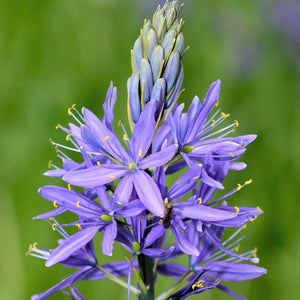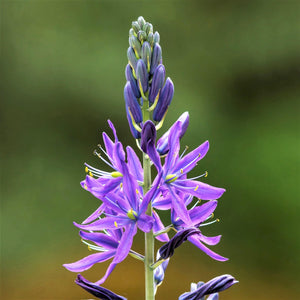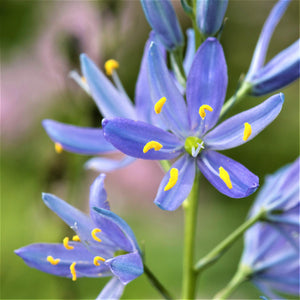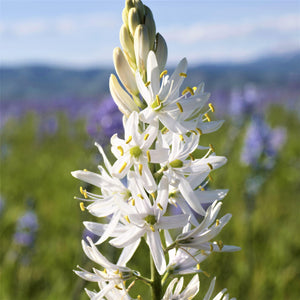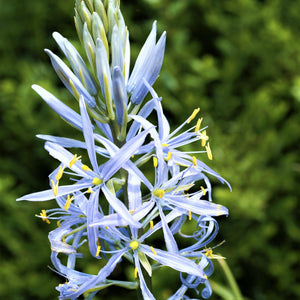- Home
- Planting Guides
- Camassia Planting & Growing Guide
Camassia Planting & Growing Guide
Varieties of Camassia have grown wild the northwestern United States for centuries. These were a traditional food for native Americans who roasted the roots to eat as vegetables and also boiled them to produce a sweet, molasses-like treat. The treat for travelers who have visited Oregon and Washington in the late spring is not the taste of these plants but the breathtaking swaths of powder to violet blue that can be seen festooning fields along the highways. You can grow these sparkling spires in your landscape, too. With the right site - sunny and moist, or drier with a little shade - they'll thrive on benign neglect. And it's that just what busy gardeners are looking for, right?
Success Snapshot
PLANTING
DEPTH
4-6"

WATER
QUANTITY
Moderate; Low in dormancy
SUNLIGHT
QUANTITY
Full Sun to Partial Shade
PLANTING
PROXIMITY
6-8" Apart
BLOOM
SEASON
Late Spring through Summer
HARDINESS
ZONES
Zones 4-8
Shop Related Products

Camassia - Quamash Blue Melody
$5.95
Contains: 5 robust Camassia bulbs
Botanical Name: Camassia quamash 'Blue Melody'
Exposure: Full Sun to Partial Shade
Hardiness: Zones 4-8
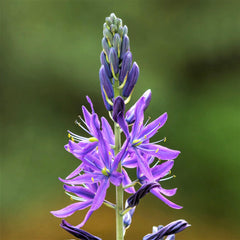
Camassia - Esculenta Indian Hyacinth
$5.95
Contains: 5 robust Camassia bulbs
Botanical Name: Camassia esculenta
Exposure: Full Sun to Partial Shade
Hardiness: Zones 4-8

Camassia - Caerulea Blue Heaven
$2.95
Contains: 5 large Camassia bulbs
Botanical Name: Camassia leichtlinii 'Blue Heavens'
Exposure: Full Sun to Partial Shade
Hardiness: Zones 4-8

Camassia - Sacajawea
$4.95
Contains: 5 large Camassia bulbs
Botanical Name: Camassia leichtlinii 'Sacajawea'
Exposure: Full Sun to Partial Shade
Hardiness: Zones 4-8

Camassia - Cusickii Wild Hyacinth
$4.95
Contains: 5 large Camassia bulbs
Botanical Name: Camassia cusickii
Exposure: Full Sun to Partial Shade
Hardiness: Zones 4-8
Camassia Planting Guide
Did you know that some edible (and totally unforgettable) strains of Camassia have been grown wild in the northwestern United States for centuries?! It's true! These plants served as staple foods for Native Americans, who roasted and boiled the roots for various recipes. Nowadays, gardeners in America grow Camassia for brilliant swaths of blue, purple, and white flowers. If you're ready to bring these bountiful bloomers into your landscape, read on!
Where to Plant
Although Camassia aren't particularly fussy when it comes to moist soil, they do fancy decent drainage. Therefore, find a location for your bulbs where the soil drains well, and they will receive full sun, especially if the soil is moist. In soils on the dry side, Camassia can be grown with just 4 to 5 hours of direct sunlight per day. If water puddles remain 5–6 hours after a hard rain, scout out another site or amend the soil with organic material to improve the drainage.
When to Plant
Camassia bulbs are best planted in the fall or early winter, with radiant blooms appearing from late spring through summer. Many gardeners advise planting between late September and early November for optimal results.
How to Plant
- Choose a location where the soil drains well, and your Camassia will receive plenty of sunlight.
- Dig holes and plant your bulbs 4–6" deep and 6–8" apart, with the small, pointy ends facing upwards.
- Water thoroughly after planting to gently soak the soil and settle it around the bulbs.
How to Grow
- Water as needed during active growth periods. About 1" of water per week is a reasonable estimate. While Camassia tolerate moist soil very well, they don’t like being in soggy soil.
- Leave the foliage in place at the end of the blooming season rather than trim it off. The leaves will gather sunlight to create food through photosynthesis, strengthening the bulbs for the future.
- Remove the foliage when the leaves turn yellow and die back as the plant slips into dormancy around mid-summer.
- Allow your Camassia plant to rest for a few months before beginning the next growing cycle.
Camassia Tips & Tricks
- Amend damp soil with compost, ground bark, or decomposed manure to raise the level 2–3" and improve the drainage.
- Camassia will do fine without fertilizing, but an application of compost once or twice a year will help keep their environment healthy.
- Leave the plants undisturbed for the best naturalizing outcome, as they are perfectly content in the same spot for years.
- Expect roots and some foliage to form in the fall, with buds in late spring and flowers in early summer.
- Feel free to snip a few flowers for charming bouquets while in bloom, as doing so will not hurt the plants.
- Notice that Camassia prefer to grow in an uninterrupted setting, meaning they're not particularly well-suited to containers.

